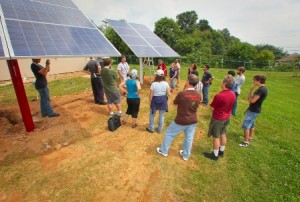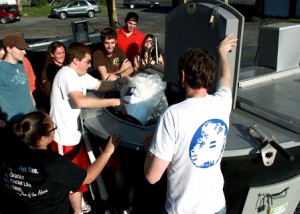
Solar panels at Metzgar Fields
Every day is Earth Day at Lafayette as a growing number of students are taking an active role in making the campus a greener place to live and learn.
Through student-faculty research and projects and involvement in numerous campus organizations, students have been the drivers behind many efforts that helped the College climb from a grade of D- to B in the national Sustainable Endowments Institute’s annual Green Report Card.
“Students have stepped up to move the College forward with regard to working toward a sustainable community,” says Arthur Kney, associate professor and head of civil and environmental engineering. “It has been a united effort among faculty, staff, and administration with the students acting as the thread that has brought us all together.”
As adviser to Society of Environmental Engineers and Scientists (SEES), Kney has worked closely with student teams on a variety of green projects. He praises student leaders like Jennifer Bell ’11 (Purcellville, Va.) and Emily Clark ’12 (Kendall Park, N.J.) for mobilizing their peers in environmental efforts.

Vegetables from the College's organic gardens
Bell, president of Lafayette Environmental Awareness and Protection (LEAP) and vice president of SEES, is an environmental standout. She received a $5,000 grant from the Clinton Global Initiative University that provided seed money to begin the organic community garden at Metzgar Fields.
She also was instrumental in securing a $41,000 state grant last year to purchase Earth Tubs for the College’s composting project. Thanks to composting, the College’s approximately 1,300 pounds of daily food waste, as well as recyclable napkins and biodegradable paper products, are collected from the dining halls, run through a water extractor, and then combined with woods chips and mulch hay in the composting units. The compost is used to fertilize the community garden.
“A college should be an example of environmental responsibility, leading the way with innovative ideas and technology,” says Bell, a double major in geology and religious studies. “There has been a shift to a green mindset among students, faculty, and administration that has made these changes possible. I am so happy to be part of a community that supports such innovation and environmental causes. Students are committed and passionate about making Lafayette as sustainable as possible, and the administration has been wonderfully supportive of our efforts.”

Students load one of the College's Earth Tub composting units
George Xiques, assistant director of facilities planning and construction and campus sustainability manager, says it’s critical that students are realistic in their environmental ideas, working with the administration to bring about change in a practical way.
“Our students fully support the use of cleaner energy, while realizing that the costs of renewable resources require research and technological improvements before we make substitutions on a large scale,” he says. “It speaks volumes about Lafayette that even though the economy has affected not only us but the country as a whole, our sustainability efforts have been efficiently executed and supported at the same levels as prior to the economic downturn.”
President of SEES, Clark is inspired by what the College has already done and optimistic about its future endeavors. She traveled with the student chapter of Engineers Without Borders to install a sustainable potable water system in rural Honduras. Her current passion is trying to implement a sustainable food loop on campus – growing food at the community garden, serving it in the College’s dining system, composting the waste, and using the compost to fertilize the community garden.
“Many of the initiatives are multidisciplinary and involve students, faculty, administration, and staff,” she says. “A significant portion of the College is committed to sustainability efforts. Student involvement has been strong and new students are consistently participating.”
Greg Miller ’13 joined LEAP as soon as he stepped on campus, helping cleanup efforts along the Bushkill Creek and the annual light bulb exchange where members go door to door in residence halls handing out compact florescent light bulbs to replace incandescent bulbs at no charge. He also is president of the TREEhouse floor in Keefe Hall, a special-interest living group whose purpose is to establish a low-impact, environmentally conscious culture.
Next year, Miller hopes to brew a new Lafayette-Lehigh rivalry.
“I am head of LEAP’s carbon committee, where we take strides to raise awareness about and address Lafayette’s carbon emissions,” says Miller, who also is working with Kney and David Veshosky, associate professor of civil and environmental engineering, to install wind turbines at Metzgar Field Complex. “We are planning an energy competition between Lafayette and Lehigh students during Earth Week, which will pit students against each other to see who can be more sustainable. We have a responsibility to do what we can to protect the world we live in.”
Other initiatives that came about through student research include the installation of solar arrays on Acopian Engineering Center and at Metzgar Fields, planting vegetation on a portion of Acopian’s roof, and adding water stations for filling reusable bottles as an alternative to single-use bottles.
Students have also become involved with sustainability through Lafayette’s efforts to integrate components in courses from across the College’s four academic divisions and in many curricular and co-curricular programs and events.
One example is the Technology Clinic course, which performed a yearlong study on environmentally friendly alternatives to the College’s practices. The group of interdisciplinary students urged President Daniel H. Weiss to sign the American College and University Presidents Climate Commitment, a national pledge to make the campus carbon neutral, which he did in 2008. Some other recommendations that were eventually instituted were regulating lighting in campus buildings, creating a sustainability officer position, instituting a more efficient recycling plan, and reducing the amount of bottled water consumed on campus.



2 Comments
Comments are closed.